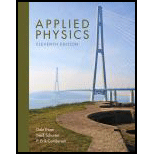
Applied Physics (11th Edition)
11th Edition
ISBN: 9780134159386
Author: Dale Ewen, Neill Schurter, Erik Gundersen
Publisher: PEARSON
expand_more
expand_more
format_list_bulleted
Concept explainers
Textbook Question
Chapter 3, Problem 9RP
A co-pilot is charting her course on a map with a scale of 1.00 cm = 20.0 km. If the plane is charted to head 13.0 cm west, 9.00 cm north, and 2.00 cm east, what is the actual displacement of the plane in km?
Expert Solution & Answer
Want to see the full answer?
Check out a sample textbook solution
Students have asked these similar questions
If d1= 3m, 60 degrees east of north, d2= 4m, 45 degrees SW and d3= 6m, 30 degrees NW, what is the magnitude of the resultant displacement?
An airplane travels at 4.5 x 10^2 km due east and then travels an unknown distance due north. Finally, it returns to its starting point by travelling a distance of 525 km. How far did the airplane travelled due north?
You are on a treasure hunt and your map says "Walk due west for 86.1 paces, then walk 50.0 ° north of west for 65.5 paces, and finally walk due north for 11.9 paces." What is the magnitude of the component of your displacement in the direction (a) due north and (b) due west?
Chapter 3 Solutions
Applied Physics (11th Edition)
Ch. 3.1 - Using the scale 1.0 cm = 50km, find the length of...Ch. 3.1 - Using the scale 1.0 cm = 50km, find the length of...Ch. 3.1 - Using the scale 1.0 cm = 50km, find the length of...Ch. 3.1 - Using the scale 1.0 cm = 50km, find the length of...Ch. 3.1 - Using the scale 1.0 cm = 50km, find the length of...Ch. 3.1 - Using the scale 1.0 cm = 50km, find the length of...Ch. 3.1 - Draw the vectors in Problems 1 through 6 using the...Ch. 3.1 - Draw the vectors in Problems 1 through 6 using the...Ch. 3.1 - Draw the vectors in Problems 1 through 6 using the...Ch. 3.1 - Draw the vectors in Problems 1 through 6 using the...
Ch. 3.1 - Draw the vectors in Problems 1 through 6 using the...Ch. 3.1 - Draw the vectors in Problems 1 through 6 using the...Ch. 3.1 - Using the scale 14 in. = 20 mi, find the length of...Ch. 3.1 - Using the scale 14 in. = 20 mi, find the length of...Ch. 3.1 - Using the scale 14 in. = 20 mi, find the length of...Ch. 3.1 - Using the scale 14 in. = 20 mi, find the length of...Ch. 3.1 - Using the scale 14 in. = 20 mi, find the length of...Ch. 3.1 - Using the scale 14 in. = 20 mi, find the length of...Ch. 3.1 - Draw the vectors in Problems 13 through 18 using...Ch. 3.1 - Draw the vectors in Problems 13 through 18 using...Ch. 3.1 - Draw the vectors in Problems 13 through 18 using...Ch. 3.1 - Draw the vectors in Problems 13 through 18 using...Ch. 3.1 - Draw the vectors in Problems 13 through 18 using...Ch. 3.1 - Draw the vectors in Problems 13 through 18 using...Ch. 3.2 - Find the x- and y-components of each vector in the...Ch. 3.2 - Find the x- and y-components of each vector in the...Ch. 3.2 - Find the x- and y-components of each vector in the...Ch. 3.2 - Find the x- and y-components of each vector in the...Ch. 3.2 - Find the x- and y-components of each vector in the...Ch. 3.2 - Find the x- and y-components of each vector in the...Ch. 3.2 - Find the x- and y-components of each vector in the...Ch. 3.2 - Find the x- and y-components of each vector in the...Ch. 3.2 - Find the x- and y-components of each vector in the...Ch. 3.2 - Find the x- and y-components of each vector in the...Ch. 3.2 - Make a sketch of each vector in standard position....Ch. 3.2 - Make a sketch of each vector in standard position....Ch. 3.2 - Make a sketch of each vector in standard position....Ch. 3.2 - Make a sketch of each vector in standard position....Ch. 3.2 - Make a sketch of each vector in standard position....Ch. 3.2 - Make a sketch of each vector in standard position....Ch. 3.2 - Make a sketch of each vector in standard position....Ch. 3.2 - Make a sketch of each vector in standard position....Ch. 3.2 - Find the x- and y- components of each vector. 19.Ch. 3.2 - Find the x- and y- components of each vector. 20.Ch. 3.2 - Find the x- and y- components of each vector. 21.Ch. 3.2 - Find the x- and y- components of each vector. 22.Ch. 3.2 - Find the x- and y- components of each vector. 23.Ch. 3.2 - Find the x- and y- components of each vector. 24.Ch. 3.2 - Find the x- and y-components of each vector given...Ch. 3.2 - Find the x- and y-components of each vector given...Ch. 3.2 - Find the x- and y-components of each vector given...Ch. 3.2 - Find the x- and y-components of each vector given...Ch. 3.2 - Find the x- and y-components of each vector given...Ch. 3.2 - Find the x- and y-components of each vector given...Ch. 3.3 - Use graph paper to find the resultant of each...Ch. 3.3 - Use graph paper to find the resultant of each...Ch. 3.3 - Use graph paper to find the resultant of each...Ch. 3.3 - Use graph paper to find the resultant of each...Ch. 3.3 - Use graph paper to find the resultant of each...Ch. 3.3 - Use graph paper to find the resultant of each...Ch. 3.3 - Use graph paper to find the resultant of each...Ch. 3.3 - Use graph paper to find the resultant of each...Ch. 3.3 - Use graph paper to find the resultant of each...Ch. 3.3 - Use graph paper to find the resultant or each...Ch. 3.3 - Use graph paper to find the resultant or each...Ch. 3.3 - Use graph paper to find the resultant of each...Ch. 3.3 - Use graph paper to find the resultant of each...Ch. 3.3 - Use graph paper to find the resultant of each...Ch. 3.3 - Find the x- and y- components of each resultant...Ch. 3.3 - Find the x- and y- components of each resultant...Ch. 3.3 - Find the x- and y- components of each resultant...Ch. 3.3 - Find the x- and y- components of each resultant...Ch. 3.3 - Find the x- and y- components of each resultant...Ch. 3.3 - Find the x- and y- components of each resultant...Ch. 3.3 - Find the x- and y- components of each resultant...Ch. 3.3 - Find the x- and y- components of each resultant...Ch. 3.3 - Find the x- and y- components of each resultant...Ch. 3.3 - Find the x- and y- components of each resultant...Ch. 3.3 - For each set of vectors, graph and find the x- and...Ch. 3.3 - For each set of vectors, graph and find the x- and...Ch. 3.3 - For each set of vectors, graph and find the x- and...Ch. 3.3 - For each set of vectors, graph and find the x- and...Ch. 3.3 - For each set of vectors, graph and find the x- and...Ch. 3.3 - For each set of vectors, graph and find the x- and...Ch. 3.3 - In Problems 31 through 42, find each resultant...Ch. 3.3 - In Problems 31 through 42, find each resultant...Ch. 3.3 - In Problems 31 through 42, find each resultant...Ch. 3.3 - In Problems 31 through 42, find each resultant...Ch. 3.3 - In Problems 31 through 42, find each resultant...Ch. 3.3 - In Problems 31 through 42, rind each resultant...Ch. 3.3 - In Problems 31 through 42, find each resultant...Ch. 3.3 - In Problems 31 through 42, find each resultant...Ch. 3.3 - In Problems 31 through 42, find each resultant...Ch. 3.3 - In Problems 31 through 42, find each resultant...Ch. 3.3 - In Problems 31 through 42, find each resultant...Ch. 3.3 - In Problems 31 through 42, find each resultant...Ch. 3.3 - A road grader must go around a pond by traveling...Ch. 3.3 - An earthmover must go north 350 m and then west...Ch. 3.3 - An airplane takes off and flies 225 km on a course...Ch. 3.3 - A ship travels 50.0 mi on a course of 15.0 south...Ch. 3.3 - A ship travels 135 km from port on a course of...Ch. 3.3 - A ship travels 145 km from port on a course of...Ch. 3 - Displacement a. can be interchanged with...Ch. 3 - When adding vectors, the order in which they are...Ch. 3 - A vector is in standard position when its initial...Ch. 3 - Discuss number plane, origin, and axis in your own...Ch. 3 - Can every vector be described in terms of its...Ch. 3 - Describe how to add two or more vectors...Ch. 3 - Describe how to find a resultant vector if given...Ch. 3 - Is a vector limited to a single position in the...Ch. 3 - Is the angle of a vector in standard position...Ch. 3 - What are the limits on the angle measure of a...Ch. 3 - Describe how to find the x- and y-components of a...Ch. 3 - Describe how to find a vector in standard position...Ch. 3 - Find the x- and y-components of vector R, which...Ch. 3 - Find the x- and y-components of vector R, which...Ch. 3 - Find the x- and y-components of vector R, which...Ch. 3 - Vector R has length 9.00 cm at 240.0. Find its x-...Ch. 3 - Vector R has length 9.00 cm at 40.0. Find its x-...Ch. 3 - Vector R has length 18.0 cm at 305.0. Find its x-...Ch. 3 - A hiker is plotting his course on a map with a...Ch. 3 - A hiker is plotting his course on a map with a...Ch. 3 - A co-pilot is charting her course on a map with a...Ch. 3 - A co-pilot is charting her course on a map with a...Ch. 3 - Vector R has x-component = +14.0 and y-component =...Ch. 3 - Vector R has x-component = -5.00 and y-component =...Ch. 3 - Vector R has x-component = +8.00 and y-component =...Ch. 3 - Vector R has x-component = -3.00 and y-component =...Ch. 3 - Vectors A, B, and C are given. Vector A has...Ch. 3 - Vectors A, B, and C are given. Vector A has...Ch. 3 - Vectors A, B. and C are given. Vector A has...Ch. 3 - Vectors A, B, and C are given. Vector A has...Ch. 3 - Graph and find x- and y-components of each...Ch. 3 - Graph and find the x- and y-components of each...Ch. 3 - An airplane takes off and flies 245 km on a course...Ch. 3 - A ship travels 155 km from port on a course of...Ch. 3 - The New Clark Bridge is an elegant cable-stayed...Ch. 3 - Frank just learned that the 800-m section of...Ch. 3 - Power cables need to be suspended by the power...Ch. 3 - With the airplane cruising at 30,000 ft, the...
Additional Science Textbook Solutions
Find more solutions based on key concepts
A wire carrying a 30.0-A current passes between the poles of a strong magnet that is perpendicular to its field...
University Physics Volume 2
(II) Show that the radius r of the mth dark Newton’s ring, as viewed from directly above (Fig. 34–18), is given...
Physics for Scientists and Engineers with Modern Physics
What kinds of living things are corals? How do corals obtain nutrients?
Conceptual Integrated Science
In an immersion measurement of a woman's density, she is found to have a mass of 62.0 kg in air an apparent mas...
University Physics Volume 1
3. What is free-fall, and why does it make you weightless? Briefly describe why astronauts are weightless in th...
The Cosmic Perspective (8th Edition)
Show that 1 V/m is the same as 1 N/C.
Essential University Physics: Volume 2 (3rd Edition)
Knowledge Booster
Learn more about
Need a deep-dive on the concept behind this application? Look no further. Learn more about this topic, physics and related others by exploring similar questions and additional content below.Similar questions
- Vector A has x and y components of 8.70 cm and 15.0 cm, respectively; vector B has x and y components of 13.2 cm and 6.60 cm, respectively. If AB+3C=0, what are the components of C?arrow_forwardA delivery man starts at the post office, chives 40 km north, then 20 km west, then 60 km northeast, and finally 50 km north to stop for lunch. Use a graphical method to find his net displacement vector.arrow_forwardWhat is the x component of the vector shown in Figure OQ1.9? (a) 3 cm (b) 6 cm (c) 4cm (d) 6cm (e) none of those answers Figure OQ1.9 Objective Questions 9 and 10.arrow_forward
- Figure OQ1.13 shows two vectors D1 and D2. Which of the possibilities (a) through (d) is the vector D22D1, or (e) is it none of them? Figure OQ1.13arrow_forwardWhat is the y component of the vector shown in Figure OQ1.9? (a) 3 cm (b) 6 cm (c) 4 cm (d) 6 cm (e) none of those answers Figure OQ1.9 Objective Questions 9 and 10.arrow_forwardThree displacement vectors of a croquet ball are shown in Figure P1.44, where |A|=20.0units, |B|=40.0units, and |C|=30.0units. Find (a) the resultant in unit-vector notation and (b) the magnitude and direction of the resultant displacement. Figure P1.44arrow_forward
- A commuter airplane starts from an airport and takes the route shown in Figure P1.71. The plane first flies to city A, located 175 km away in a direction 30.0 north of east. Next, it flies for 150. km 20.0 west of north, to city B. Finally, the plane flies 190. km due west, to city C. Find the location of city C relative to the location of the starting point. Figure P1.71arrow_forwardConsider the three displacement vectors A=(3i3j)m, B=(i4j)m, and C=(2i+5j)m. Use the component method to determine (a) the magnitude and direction of the vector D=A+B+C and (b) the magnitude and direction of E=AB+C.arrow_forwardThe magnitudes of two vectors A and B are 12 units and 8 units, respectively. What are the largest and smallest possible values for the magnitude of the resultant vector R = A + B? (a) 14.4 and 4 (b) 12 and 8 (c) 20 and 4 (d) none of these.arrow_forward
- Figure P3.28 illustrates typical proportions of male (m) and female (f) anatomies. The displacements d1m and d1f from the soles of the feet to the navel have magnitudes of 104 cm and 64.0 cm. respectively. The displacements d2m and d2f from the navel to outstretched fingertips have magnitudes of 100 cm and 86.0 cm, respectively. Find the vector sum of these displacements d3=d1+d2 for both people. Figure P3.28arrow_forwardWhat is the x component of the vector shown in Figure OQ3.9? (a) 3 cm (b) 6 cm (c) 4 cm (d) 6 cm (e) none of those answersarrow_forwardVector A has x and y components of 8.70 cm and 15.0 cm, respectively; vector R has x and y components of 13.2 cm and 6.60 cm, respectively. If AB+3C=0, what are the components of C?arrow_forward
arrow_back_ios
SEE MORE QUESTIONS
arrow_forward_ios
Recommended textbooks for you
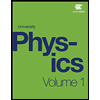 University Physics Volume 1PhysicsISBN:9781938168277Author:William Moebs, Samuel J. Ling, Jeff SannyPublisher:OpenStax - Rice University
University Physics Volume 1PhysicsISBN:9781938168277Author:William Moebs, Samuel J. Ling, Jeff SannyPublisher:OpenStax - Rice University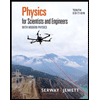 Physics for Scientists and Engineers with Modern ...PhysicsISBN:9781337553292Author:Raymond A. Serway, John W. JewettPublisher:Cengage Learning
Physics for Scientists and Engineers with Modern ...PhysicsISBN:9781337553292Author:Raymond A. Serway, John W. JewettPublisher:Cengage Learning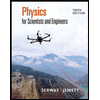 Physics for Scientists and EngineersPhysicsISBN:9781337553278Author:Raymond A. Serway, John W. JewettPublisher:Cengage Learning
Physics for Scientists and EngineersPhysicsISBN:9781337553278Author:Raymond A. Serway, John W. JewettPublisher:Cengage Learning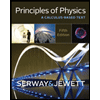 Principles of Physics: A Calculus-Based TextPhysicsISBN:9781133104261Author:Raymond A. Serway, John W. JewettPublisher:Cengage Learning
Principles of Physics: A Calculus-Based TextPhysicsISBN:9781133104261Author:Raymond A. Serway, John W. JewettPublisher:Cengage Learning Physics for Scientists and Engineers, Technology ...PhysicsISBN:9781305116399Author:Raymond A. Serway, John W. JewettPublisher:Cengage Learning
Physics for Scientists and Engineers, Technology ...PhysicsISBN:9781305116399Author:Raymond A. Serway, John W. JewettPublisher:Cengage Learning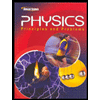 Glencoe Physics: Principles and Problems, Student...PhysicsISBN:9780078807213Author:Paul W. ZitzewitzPublisher:Glencoe/McGraw-Hill
Glencoe Physics: Principles and Problems, Student...PhysicsISBN:9780078807213Author:Paul W. ZitzewitzPublisher:Glencoe/McGraw-Hill

University Physics Volume 1
Physics
ISBN:9781938168277
Author:William Moebs, Samuel J. Ling, Jeff Sanny
Publisher:OpenStax - Rice University

Physics for Scientists and Engineers with Modern ...
Physics
ISBN:9781337553292
Author:Raymond A. Serway, John W. Jewett
Publisher:Cengage Learning

Physics for Scientists and Engineers
Physics
ISBN:9781337553278
Author:Raymond A. Serway, John W. Jewett
Publisher:Cengage Learning

Principles of Physics: A Calculus-Based Text
Physics
ISBN:9781133104261
Author:Raymond A. Serway, John W. Jewett
Publisher:Cengage Learning

Physics for Scientists and Engineers, Technology ...
Physics
ISBN:9781305116399
Author:Raymond A. Serway, John W. Jewett
Publisher:Cengage Learning

Glencoe Physics: Principles and Problems, Student...
Physics
ISBN:9780078807213
Author:Paul W. Zitzewitz
Publisher:Glencoe/McGraw-Hill
Introduction to Vectors and Their Operations; Author: Professor Dave Explains;https://www.youtube.com/watch?v=KBSCMTYaH1s;License: Standard YouTube License, CC-BY